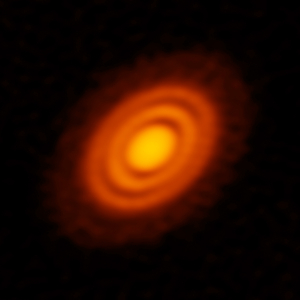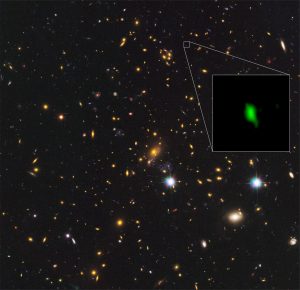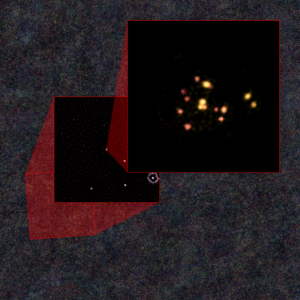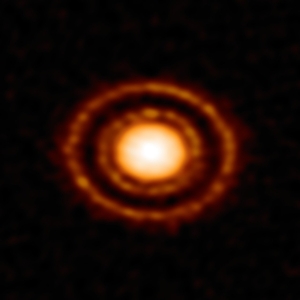ALMA image of the protoplanetary disk surrounding the young star HD 163296 as seen in dust. New observations suggested that two planets, each about the size of Saturn, are in orbit around the star. These planets, which are not yet fully formed, revealed themselves by the dual imprint they left in both the dust and the gas portions of the star’s protoplanetary disk.


Glowing Core of Brilliant Galaxy NGC 5643
This composite image shows the center of a galaxy named NGC 5643. This galaxy is located 55 million light-years from Earth in the constellation of Lupus (The Wolf). It is one of a class of objects known as a Seyfert galaxy. Seyfert galaxies have very luminous centers — thought to be powered by material being accreted onto a supermassive black hole lurking within — that can also be shrouded and obscured by clouds of dust and intergalactic material.
As a result, it can be difficult to observe the active center of a Seyfert galaxy. NGC 5643 poses a further challenge; it is viewed at a high inclination, making it even trickier to view its inner workings. However, scientists have used the Atacama Large Millimeter/submillimeter Array (ALMA) together with archival data from the Multi Unit Spectroscopic Explorer (MUSE) instrument on ESO’s Very Large Telescope to reveal this view of NGC 5643 — complete with energetic outflowing ionized gas pouring out into space.
These impressive outflows stretch out on either side of the galaxy and are caused by matter being ejected from the accretion disk of the supermassive black hole at NGC 5643’s core. Combined, the ALMA and VLT data show the galaxy’s central region to have two distinct components: a spiraling, rotating disk (ALMA data shown in red) consisting of cold molecular gas traced by carbon monoxide, and the outflowing gas, traced by ionized oxygen and hydrogen (VLT data shown in blue-orange hues) perpendicular to the inner nuclear disk.

ALMA Finds Most-Distant Oxygen in the Universe
This image shows the galaxy cluster MACS J1149.5+2223 taken with the NASA/ESA Hubble Space Telescope and the inset image is the galaxy MACS1149-JD1 located 13.28 billion light-years away observed with ALMA. Here, the oxygen distribution detected with ALMA is depicted in green.

Zoom In to Young Galaxy Cluster
Zooming in to the galaxies discovered by ALMA that are evolving into a galaxy cluster. The outer field is from data taken by the Hershel Space Observatory. The middle image — a portion of a much-wider survey by NSF’s South Pole Telescope — uncovered the distant galactic source that was studied by ALMA to reveal the 14 galaxies.

ALMA Reveals Inner Web of Stellar Nursery
This spectacular and unusual image shows part of the famous Orion Nebula, a star formation region lying about 1350 light-years from Earth. It combines a mosaic of millimeter wavelength images from the Atacama Large Millimeter/submillimeter Array (ALMA) and the IRAM 30-meter telescope, shown in red, with a more familiar infrared view from the HAWK-I instrument on ESO’s Very Large Telescope shown in blue. The group of bright blue-white stars at the left is the Trapezium Cluster, hot young stars that are only a few million years old.

Young Planet Makes a Scene
Nestled in the Ophiuchus star-forming region, 410 light-years from the Sun, a protoplanetary disk is slowly taking shape. Dust emission from AS 209 reveals a curious pattern of rings and gaps surrounding the young star.
Protoplanetary disks are composed of gas and dust particles, forming after the collapse of a molecular cloud. As matter from the newly formed star begins to fall inward, the material will flatten into a disk around the young star. These disks provide the foundational material that one day will become orbiting planets, moons and other minor bodies.
At less than a million years old, this system has two clearly distinct gaps carved out from the disk. The wide outer gap is a largely a dust-free zone, suggesting a Saturn-like planet may be forming. The distance between this gap and its host star is more than three times the distance between Neptune and the Sun in our own solar system. The thinner, inner dust gap could have been formed by a smaller planet nearer to the star, or by perturbations in the disk caused by same proposed planetary body that carved the larger outer gap in the disk.
This striking image was captured with the Atacama Large Millimeter/submillimeter Array (ALMA) telescope on the Chajnantor Plateau in Chile.





